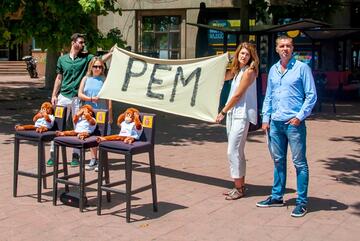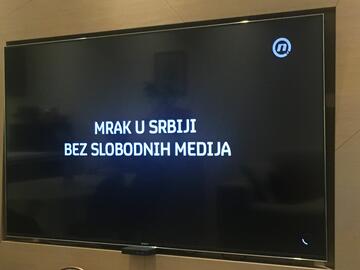
June 2022, Belgrade, Serbia, Protest against Regulatory Authority For Electronic Media © Zivko Trikic/Shutterstock
The issue of the public allocation of national broadcasting frequencies in Serbia seems to have come to a public halt, after a few important developments in the past months that have shown how contentious this issue is and exposed the weaknesses of the institutional framework of Serbia.
The usual suspects receive (again) the national TV frequencies
The whole dispute started on 29 July 2022 when Serbia’s Electronic Media Regulatory Body (REM) awarded the four national broadcasting frequencies for a period of eight years to the same four televisions (Happy, Pink, B92 and Prva) that had previously received them. The allocation occurred in spite of the numerous shortcomings in the performance of these televisions, including at least 12,000 violations of the advertising act in the previous years and of the fact that several reports for hate speech and violence were filed against them. The award decision started a public outcry and attracted severe criticism by local and international stakeholders since these televisions are all known to be supportive of the SNS, the Serbian Progressive Party, currently in power in Serbia. National and international press freedom organisations considered the process of allocation of the frequencies to be in violation of the principle of pluralism of the public broadcasting organisations and of the principles on the allocation of licences. Few days later, the REM announced that a fifth national frequency would be allocated and that the whole process would be over by the end of the autumn.
The EU progress report
The whole issue was extensively covered by the EU in its 2022 progress report which highlighted how the REM had awarded the four national frequencies to the same broadcasters as in the previous eight years in spite of the fact that all of them had received warnings by the REM due to violations of their legal obligations. The EU reiterated the need to respect the principle of media pluralism and transparency in the process of allocating the frequencies. Moreover, in the progress report the EU quoted the ODIHR final report on the April 2022 elections in Serbia. In its final report the ODIHR noticed that the REM remained passive in overseeing the conduct of Serbian media during the recent electoral campaign. ODIHR also remarked that national public broadcasters provided “extensive uncritical news coverage to public officials who were also candidates” while “private TV channels with a national coverage [...] allocated some 90% of coverage in news programmes to the president and government officials portraying them generally positively”. In other words, the REM had failed in its role of ensuring the correct application of the rules regulating the electoral campaign on the public broadcasters.
The saga of the fifth frequency begins
The public tender for the fifth national frequency was launched in August 2022 with a deadline set for the 11 October for the submission of bids. Four televisions eventually applied , amongst them TV Nova S which produces a number of successful programmes and is known for its critical stance towards the government.
According to Nova S, the deadline for the REM to decide on the applications was 30 days and it expired on the 26 November , however on 29 November the chairperson of the REM herself denied that there was any deadline for the awarding of frequencies and that the decision would be brought during one of the next sessions, without making any firm commitments.
Darkness in Serbia
The applicants and those following the process were worried that the whole procedure was just an excuse to buy time and eventually avoid awarding the frequencies. This led to a significant protest of the televisions belonging to the operator United Group, N1 and TV Nova S. On 6 December, the two TVs stopped their broadcasting and for the whole day they broadcasted a black screen displaying the text “Darkness in Serbia without free media”. The protest had a large impact and its timing coincided with the summit EU – Western Balkans. President Vucic himself was forced to comment on it during the summit itself criticising the TVs and stating that they were protesting more in their own interest than in that of the public. The protest of the TVs was later followed by another organised within the National Parliament by the members of the opposition who showed their support for the two televisions and displayed the same message as the two TVs did.
“Darkness in Serbia without free media”
REM goes on strike
While the protest of the TVs did not explicitly refer to the issue of the fifth frequency in Serbia, the message was nevertheless clear and the reaction of the REM was immediate. The REM suspended their work on 9 December via an urgent phone session . Later on that month the chairwoman of the REM informed the Parliamentary Committee on Culture and Information that the REM had gone on strike because of the “violent coordinated pressure” that they were receiving from opposition groups and in particular because of the pressure from the United group. Debates followed whether such a strike was legal or not, but the result was that time was passing and once more the decision on the allocation of the fifth frequency was delayed. The strike eventually ended on 21 December 2022 after the REM received the support of the parliamentary committee as well as that of the Minister of Information and Telecommunications.
The saga continues….
The end of the strike was not the end of the saga. Two days after the end of the strike the president of the REM itself announced publicly that the REM will not allocate the fifth national frequency while there is a pending court dispute with one of the applicants. The reference was to TV Nova S, which on 20 December had started a court case for administrative silence against the REM because the deadline to award the frequency had passed and no decision was brought. While the court case had been initiated to urge the REM to complete the procedure, the REM referred to it as a reason to continue postponing the decision on the allocation of the fifth frequency, even if the case can last years. The chairperson of the REM, Ms. Olivera Zekic, in fact stated that the court procedure “will last as long as it lasts. We can’t interfere in the work of judicial bodies. Was anybody forcing them (Nova S) to take us to court? No, I only regret that because of them, also other interested TVs will have to wait”. The paradox is that the lawsuit against the administrative silence is now being used by the REM to continue their silence and has become the main excuse to delay solving the issue. A similar complaint raised with the Ombudsman’s Office did not produce any results.
To date, there is no end in sight to this issue, even if eight months have passed since the call for the fifth frequency was launched and the deadline expired more than 5 months ago. The fact that the issue was raised both by the European Commission in October and most recently, in April 2023, by the Foreign Affairs Committee of the European Parliament did not unblock the situation. Indeed when commenting on such a report, the chairperson of the REM while rejecting the criticism of the European Parliament clearly stated that the REM has no legal obligation to issue the fifth frequency and that four national frequencies are even too much for the Serbian market. The latest statement seems to confirm what many suspected at the beginning: that the fifth national frequency will never be allocated or that it will be allocated when it is too late and it becomes meaningless.
Tags: Serbia Media pluralism Public broadcasting Political pressure
This content is part of the Media Freedom Rapid Response (MFRR), a Europe-wide mechanism which tracks, monitors and responds to violations of press and media freedom in EU Member States and Candidate Countries. The project is co-funded by the European Commission.



